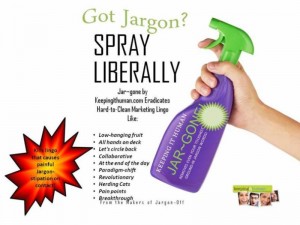Turn Jargon into Human Speak
Jargon. It’s the worst. We’ve all heard it, done it and regretted it after. Jargon is more than just lazy; it’s marketing air pollution. I call it “Jargon-monoxide poisoning” and it costs you more than you think. Jargon is more than a turn-off to your prospects and customers. It hurts you, and your credibility because it pollutes your message and dilutes any chance for clarity and differentiation you have. We’re all busy and jargon makes it harder to be heard. Your prospect gives 3 – 7 seconds, and in that time they’ve tuned you in or tuned you out. Do you really want to waste it with meaningless words?
Imagine sitting in a bar talking to your closest friend and describing what your company does. If you talked like this: “We robustly synergize onboarding best-of-breed solutions,” your friend would laugh in your face. It’s not how people talk. If you talk like this, prospects are thinking, “Wow. That’s how I’ll be treated: like a robot and not a person.” For some reason, too many marketers transform into robots when they start communicating. Yet, when we’re talking in casual conversation, we’re simple and clear. We use human speak. That’s how we should communicate all the time – like you are talking to trusted friends.
Six Steps to Human Speak
Spare the marketing air and your prospects’ time and energy. Here are six ways to turn robotic marketing-speak that cause “Jargonstipation” into human speak that connects:
1. Simple words and no jargon. You don’t get extra points for big words. Big words sound important; they’re not. Real experts know how to make the complex simple. It’s the difference between “cloud-based computing solutions to leverage collaboration,” and “we allow employees to access company data securely, anytime anywhere, so they can work freely and unchained to a desk.” Always say it the most basic way. You are not dumbing down your message; rather, you are making it accessible to more people when you speak plainly to busy people. Clarity is the communicator’s burden, and busy people won’t take the time to decode your message. They shouldn’t have to.
2. The human, personal need. We can talk about productivity and collaboration all day. Who cares? What human need is being solved by those tools? If collaboration enables people to enhance their internal reputation and visibility, then say it. Underneath the professional, rational need is a human need. And you must appeal to that because you are talking to a human being even in a B2B context. Humans buy from other humans. Human speak addresses the human need.
3. Get rid of ‘me-too’s.’ If it sounds like everybody else’s stuff, leave it out. Here’s a test: line up your written marketing next to your competition’s content. If you took out the company name, does the content read the same? Is your voice and personality detectable? If not, you have a differentiation issue. Revisit points 1 and 2 above. Get rid of me-too messaging.
4. Use your prospect / customer’s language. People use certain words for a reason. Weave some of those words into your language. It demonstrates that you are listening to your audience and you are mirroring back their needs. That’s empathy and understanding.
5. Short and sweet. People are busy. We are all busy. Being simple in wording and short in delivery, respects peoples’ time and fragmented attention. That is one thing we all have little of these days. That and patience.
6. Turn ME into YOU. Make a content YOU-turn. I’ve long referred to ‘me, my, our, we’ as the “Beaches” approach to marketing and it’s a huge turn-off. In the great movie, Beaches, with Barbara Hershey and Better Midler, Midler’s character spends a lot of time talking about herself and her life, then turns to her friend who is dying of cancer, played by Barbara Hershey, and says, “That’s enough about me. What do YOU think of Me?” Stop the “our IP, our methodology, our services, our products.” Instead put the focus on your audience and their needs: you, your, their. Here’s my rule of thumb: aim for 70-80% of your language to be focused on the audience’s YOU, and about 20-30% on self-references (me, my, our.).
In a world of way too much noise, people (your customers and prospects) are hungry for human speak. So give it to them, increase trust and credibility, and improve your marketing results, too.
How do you keep your messaging human? What does human speak mean to you?
Leave a comment below.





